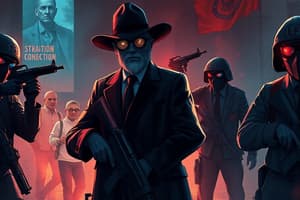Podcast
Questions and Answers
What are some of the main reasons why people are afraid of heroin?
What are some of the main reasons why people are afraid of heroin?
- It is very dangerous and addictive (correct)
- It is a drug that's widely used by criminals. (correct)
- It is a drug that is often used by low-class individuals. (correct)
- It can be very difficult to get off of heroin. (correct)
- All of the above (correct)
What are some of the arguments in favor of the predisposition model?
What are some of the arguments in favor of the predisposition model?
- Addicts are not forced into a life of crime by their use of narcotics (correct)
- The model argues against the enslavement model (correct)
- Addicts do not necessarily become involved in criminal behavior. They are already predisposed to it. (correct)
- All of the above (correct)
What are the three models that explain why drug use leads to violence?
What are the three models that explain why drug use leads to violence?
- Psychopharmacological Model (correct)
- Economic-Compulsive Model (correct)
- Systemic Violence Model (correct)
- All of the above (correct)
What are the three models that attempt to explain the connection between drugs and crime?
What are the three models that attempt to explain the connection between drugs and crime?
The "Balloon Effect" states that if drug production is suppressed in one area, the problem will simply move to a different area.
The "Balloon Effect" states that if drug production is suppressed in one area, the problem will simply move to a different area.
Which of the following methods are used by criminals to exploit and benefit from drug trafficking routes?
Which of the following methods are used by criminals to exploit and benefit from drug trafficking routes?
Which of the following are examples of how drug trafficking is controlled?
Which of the following are examples of how drug trafficking is controlled?
What are the three models of drug manufacturing?
What are the three models of drug manufacturing?
The Pure Agricultural Model of drug manufacturing requires little to no processing before the product is ready for consumption
The Pure Agricultural Model of drug manufacturing requires little to no processing before the product is ready for consumption
What are the main issues associated with the use of AA and NA programs for drug addiction?
What are the main issues associated with the use of AA and NA programs for drug addiction?
What is the goal of Harm Reduction?
What is the goal of Harm Reduction?
The term 'Mr. Big', refers to a single, all-powerful figure who controls the entire drug trade
The term 'Mr. Big', refers to a single, all-powerful figure who controls the entire drug trade
Which of the following is NOT a factor considered in determining the schedule of a drug?
Which of the following is NOT a factor considered in determining the schedule of a drug?
Flashcards
What are analgesics?
What are analgesics?
Analgesics are medications used to relieve pain. They come in various forms, like heroin, opium, fentanyl, morphine, oxycodone, and prescription drugs like Vicodin and Hydrocodone.
Describe heroin's public perception and use patterns.
Describe heroin's public perception and use patterns.
Heroin is a highly addictive opioid drug often associated with negative stereotypes and stigma. It's feared and viewed as low-class, with a high risk of addiction. While some may use it occasionally, it's infrequent and considered very risky.
What is the psychopharmacological model of drug-violence?
What is the psychopharmacological model of drug-violence?
This model suggests that drug violence is a direct result of the psychoactive effects of drugs, causing aggression and impulsive behavior. It's considered a less common explanation for drug-related violence.
Explain the economic-compulsive model of drug-violence.
Explain the economic-compulsive model of drug-violence.
Signup and view all the flashcards
Describe the systemic violence model of drug-violence.
Describe the systemic violence model of drug-violence.
Signup and view all the flashcards
What is the enslavement model of the drug-crime link?
What is the enslavement model of the drug-crime link?
Signup and view all the flashcards
Explain the predisposition model of the drug-crime link.
Explain the predisposition model of the drug-crime link.
Signup and view all the flashcards
What is the intensification model of the drug-crime link?
What is the intensification model of the drug-crime link?
Signup and view all the flashcards
Explain the victimization issues associated with drug use.
Explain the victimization issues associated with drug use.
Signup and view all the flashcards
What is the 'balloon' effect in drug trafficking?
What is the 'balloon' effect in drug trafficking?
Signup and view all the flashcards
Describe the trafficking issues surrounding drugs.
Describe the trafficking issues surrounding drugs.
Signup and view all the flashcards
Who controls the drug trade?
Who controls the drug trade?
Signup and view all the flashcards
What is the Pure Agricultural Model of drug manufacturing?
What is the Pure Agricultural Model of drug manufacturing?
Signup and view all the flashcards
Explain the Pure Chemical Model of drug manufacturing.
Explain the Pure Chemical Model of drug manufacturing.
Signup and view all the flashcards
What is the Mixed Model of drug manufacturing?
What is the Mixed Model of drug manufacturing?
Signup and view all the flashcards
Explain the role and limitations of AA/NA.
Explain the role and limitations of AA/NA.
Signup and view all the flashcards
What is the purpose of the Controlled Substance Act regarding drug control?
What is the purpose of the Controlled Substance Act regarding drug control?
Signup and view all the flashcards
What is inpatient treatment for drug addiction?
What is inpatient treatment for drug addiction?
Signup and view all the flashcards
Explain the difference between decriminalization and legalization of drugs.
Explain the difference between decriminalization and legalization of drugs.
Signup and view all the flashcards
What are harm reduction strategies regarding drug use?
What are harm reduction strategies regarding drug use?
Signup and view all the flashcards
Describe the economic impact of drug abuse.
Describe the economic impact of drug abuse.
Signup and view all the flashcards
Explain the 'Mr. Big' fallacy in the drug trade.
Explain the 'Mr. Big' fallacy in the drug trade.
Signup and view all the flashcards
What is the dominant current approach to drug control?
What is the dominant current approach to drug control?
Signup and view all the flashcards
Explain the role of predisposition in drug use.
Explain the role of predisposition in drug use.
Signup and view all the flashcards
Describe different presidential stances on the 'war on drugs'.
Describe different presidential stances on the 'war on drugs'.
Signup and view all the flashcards
What factors are considered when classifying drugs under the Controlled Substance Act?
What factors are considered when classifying drugs under the Controlled Substance Act?
Signup and view all the flashcards
Study Notes
Drug Issues and Violence
- Heroin is considered the most feared and stigmatized drug, frequently used infrequently, but is feared for its addictive potential.
- Addicts/junkies are upset when others abstain from drug use.
- Three models explain the link between drugs and violence:
- Psychopharmacological model: Drug use directly leads to violence (minority).
- Economic-compulsive model: Economic pressures related to drug use lead to violence (minority).
- Systemic violence model: Violence is embedded in the social and economic networks of drug users and sellers (majority).
Drug-Crime Link
- Enslavement model: Individuals become trapped in drug use due to accidents, mental defects, medical issues, poverty, unemployment, or temporary life problems.
- Predisposition model: Argues individuals are already predisposed to crime even before drug use.
- Intensification model: Combines elements of enslavement and predisposition models—both contain some truth, but flaws in their premises.
Victimization and Trafficking
- Drug users are more vulnerable to crime.
- Drug trafficking is often associated with other crimes, like money laundering.
- Trafficking routes are utilized by criminal networks for transporting other illicit goods.
- Cartels (Sinol, Jalisco New Generation, Gulf) and local gangs/dealers control the drug trade.
Drug Manufacturing Models
- Pure Agricultural Model: Drug production from agricultural raw materials, minimal processing.
- Pure Chemical Model: Lab-synthesized drugs, needing technical expertise.
- Mixed Model: Synthesized substances from initially agricultural products.
Harm Reduction Strategies
- Overdose education, counseling, and referral to treatment for substance use disorders.
- Distribution of opioid overdose reversal medications (like naloxone).
- Reducing transmission of infectious diseases among drug users.
Economic Cost of Drug Abuse
- $193 billion estimated cost of drug abuse in the U.S.
- $120 billion in lost productivity.
- $11 billion in healthcare costs.
- $61 billion in criminal justice costs.
Drug Control and Legalization
- Different drug schedules based on potential for misuse.
- Decriminalization: Illegal but not prosecuted.
- Legalization: Removal of legal prohibitions.
- Harm reduction is aimed at decreasing the negative consequences of drug use.
Drug Control Act Considerations
- Potential for abuse.
- Scientific knowledge regarding pharmacological effects.
- History and current pattern of abuse.
- Risk to public health.
- Dependence liability.
- Substance's role as a precursor to controlled substances.
Studying That Suits You
Use AI to generate personalized quizzes and flashcards to suit your learning preferences.




